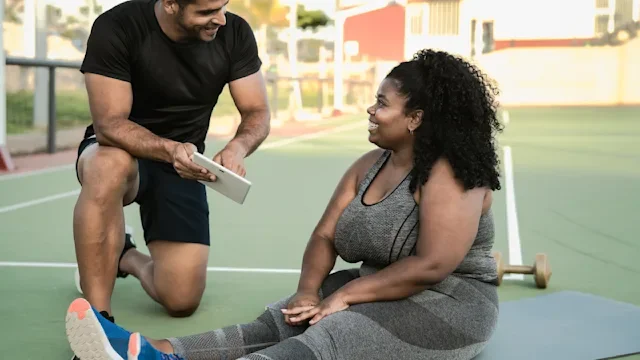Key takeaways:
Ice and heat therapy can help treat muscle aches and pains.
Generally, ice is better for acute or newer injuries, while heat is better for chronic or long-term pain.
If your symptoms don’t improve with ice or heat therapy, stop using them and talk to a healthcare professional.
Whether you have an ache, sprain, or strain, you probably want to try something quick and effective to soothe a sore muscle. Fortunately, there are lots of options. Heat and cold therapy can help with muscle aches and pains. So, you might wonder if one option is better than the other.
Learn the benefits of both to decide which treatment is right for you.
When should you use heat or ice for sore muscles?
It depends on the cause of your muscle soreness and when it started. The science on ice versus heat for pain relief is mixed. But generally, ice may help reduce pain and swelling in the first 24 to 48 hours after new muscle aches, sprains, or strains. After the first couple of days, heat may be more effective for relieving pain and stiffness.
Search and compare options
How does ice therapy work?
Ice or cold therapy narrows blood vessels, decreasing circulation to an injury. By slowing blood flow to the affected area, it can help reduce pain, swelling, and inflammation.
There are several ways to apply ice therapy:
Cold towels
Ice packs or cold gel packs
Cold-water immersion or ice baths
Coolant sprays
Ice massage
Some ice therapy applications, like whole-body cryotherapy chambers, are less accessible and may require medical supervision. But most methods are convenient and easy to do at home.
Ice therapy benefits
Ice therapy may reduce your sensitivity to pain by lowering nerve activity in the targeted area. This makes it a useful treatment option for acute injuries –– those that occur suddenly and have a known cause –– like swollen joints and tendons.
Research suggests that ice therapy is most effective within the first hours after an acute injury. That explains why ice is commonly used after accidents like slamming a finger in a door or exercise-induced injuries like a pulled muscle. If pain and swelling don’t improve after a couple of days, stop using ice and talk to a healthcare professional.
Do Epsom salt baths relieve muscle pain? They might. Here’s what the science says about the benefits of Epsom salt baths.
Foam rolling may help, too. Try these foam rolling exercises to soothe muscle aches and pains.
Got lower back pain? You’re not alone — it’s very common. Many treatments, including these targeted exercises, can ease pain and stiffness.
Ice therapy limitations
Although it can treat new injuries, ice therapy may sometimes do more harm than good. Icing for too long may delay recovery. It can also cause the following symptoms and eventually damage your skin:
Tingling
Numbness
Itching
People with circulation or nerve problems from conditions like diabetes and neuropathy, should use caution when applying ice. That’s because decreased sensation in certain body parts can make it difficult to sense the potentially harmful effects of ice therapy.
Read more like this
Explore these related articles, suggested for readers like you.
Full-body methods like cold-water immersion can also affect your blood pressure and heart rate. If you have a medical condition such as hypertension, heart disease, or impaired circulation, talk to a healthcare professional before trying these methods.
How does heat therapy work?
Heat therapy opens blood vessels, increasing circulation to the affected areas. Increased blood flow may help relieve pain, relax tight muscles, and improve range of motion.
Like ice therapy, heat therapy can be applied in several ways, including:
Hot towels
Hot water bottles
Heat packs, pads, or wraps
Hot tubs or baths
While saunas and hot baths provide a whole-body treatment, applications like heating pads and warm compresses target specific areas of your body.
Heat therapy benefits
Increased blood flow to the injury site may help your body repair damaged tissues. For example, heat therapy can help manage ongoing lower back pain, especially when combined with exercise. It can be beneficial if your injury is chronic. Overuse or chronic injuries usually develop gradually and last a long time.
Heat therapy limitations
There are downsides to heat therapy. If left on for too long, it can lead to skin burns. Avoid heat on areas with inflammation or open wounds.
As with ice therapy, people with nerve damage from conditions like diabetes or multiple sclerosis should be careful when applying heat. If you’re pregnant, have heart disease, or high blood pressure, talk to a healthcare professional before using heat therapy.
How long should you apply heat or ice?
Like any treatment, correctly applying ice or heat therapy is critical to reaping its potential benefits:
First, place a barrier, such as a towel or clothing, between the ice or hot pack and your skin to prevent burns. You can add additional barriers if needed.
Then, monitor the area for redness or other signs of irritation.
Generally, you can apply ice or heat therapy for up to 20 minutes at a time.
Do ice and heat therapy prevent muscle soreness?
The evidence for using ice and heat therapy to prevent delayed-onset muscle soreness is mixed. One review found that applying ice or heat within an hour after a workout can reduce muscle soreness. But there’s also some evidence that using heat therapy before exercise may decrease soreness.
Should you use ice or heat for pulled or torn muscles?
A pulled muscle (strain) and a torn muscle are both soft-tissue injuries. Experts recommend ice therapy for newly pulled or torn muscles. Ice packs or cold treatments may help with pain, swelling, and inflammation. After a few days, you can switch to heat therapy to promote healing. Using heat before that can make inflammation or other symptoms worse.
When should you combine ice and heat therapy?
In some cases, using both ice and heat therapy may be helpful. For example, you might use an ice pack for acute arthritis pain and a heat pack for ongoing joint stiffness related to your arthritis.
One study found that combining hot and cold treatments helped relieve knee pain due to osteoarthritis better than ice alone.
When is contrast bath hydrotherapy necessary?
Contrast hydrotherapy is a treatment that involves alternating between hot and cold water. In contrast bath hydrotherapy, you submerge all or part of your body in hot and then cold water. You repeat the process several times. It may be helpful for exercise recovery or various conditions, including knee arthritis. A physical therapist might include contrast baths as part of a treatment plan to relieve pain, reduce muscle spasms and inflammation, and improve mobility.
Frequently asked questions
Small studies suggest that several drinks may help reduce muscle soreness or inflammation after exercise, including:
While some drinks may help with muscle soreness and workout recovery, their effectiveness can vary. No drink is guaranteed to relieve pain after exercise or injury.
Generally, it’s not recommended to use heat right after ice for new soft tissue injuries. Experts suggest ice for the first couple of days before switching to heat. Using heat too soon may increase swelling. Avoid using heat right after ice without a healthcare professional’s approval.
In addition to heat or ice, the following may help soothe sore muscles:
Practice active recovery and gentle stretching
Try foam rolling
Get a massage
Stay hydrated
Get restful sleep
Small studies suggest that several drinks may help reduce muscle soreness or inflammation after exercise, including:
While some drinks may help with muscle soreness and workout recovery, their effectiveness can vary. No drink is guaranteed to relieve pain after exercise or injury.
Generally, it’s not recommended to use heat right after ice for new soft tissue injuries. Experts suggest ice for the first couple of days before switching to heat. Using heat too soon may increase swelling. Avoid using heat right after ice without a healthcare professional’s approval.
In addition to heat or ice, the following may help soothe sore muscles:
Practice active recovery and gentle stretching
Try foam rolling
Get a massage
Stay hydrated
Get restful sleep
The bottom line
Heat and ice therapy are affordable and easy-to-use treatments for muscle aches and pains. But it’s important to know when and how to use each option.
Ice can reduce pain and inflammation by decreasing blood flow to the affected area and is better for acute pain or injuries. Heat can soothe and heal muscles by increasing blood flow and is more beneficial for chronic pain or injuries.
If heat or ice isn’t doing the trick for your sore muscles, talk to a healthcare professional about additional treatment options.

Why trust our experts?


References
Algafly, A. A., et al. (2007). The effect of cryotherapy on nerve conduction velocity, pain threshold and pain tolerance. British Journal of Sports Medicine.
American Pregnancy Association. (n.d.). Saunas during pregnancy.
Bieuzen, F., et al. (2013). Contrast water therapy and exercise induced muscle damage: A systematic review and meta-analysis. PLoS One.
Bleakley, C. M., et al. (2012). Do thermal agents affect range of movement and mechanical properties in soft tissues? A systematic review. Archives of Physical Medicine and Rehabilitation.
Cheung, K., et al. (2003). Delayed onset muscle soreness: Treatment strategies and performance factors. Sports Medicine.
Clifford, T., et al. (2016). The effects of beetroot juice supplementation on indices of muscle damage following eccentric exercise. European Journal of Applied Physiology.
Corewell Health. (n.d.). When to use ice and when to use heat for aches and pains.
elFatah, M. I. A., et al. (2019). Effect of cold application versus contrast hydrotherapy on patients knee osteoarthritis outcomes. American Journal of Nursing Science.
Fakhro, M. A., et al. (2022). Comparison of total cold-water immersion’s effects to ice massage on recovery from exercise-induced muscle damage. Journal of Experimental Orthopaedics.
Fokmore Jr., P. S., et al. (2022). A review on osteoarthritis knee management via contrast bath therapy and physical therapy. Cureus.
Freiwald, J., et al. (2021). A role for superficial heat therapy in the management of non-specific, mild-to-moderate low back pain in current clinical practice: A narrative review. Life.
James, L. J., et al. (2019). Cow's milk as a post-exercise recovery drink: implications for performance and health. European Journal of Sport Science.
Kwiecien, S. Y., et al. (2021). The cold truth: The role of cryotherapy in the treatment of injury and recovery from exercise. European Journal of Applied Physiology.
Malanga, G. A., et al. (2015). Mechanisms and efficacy of heat and cold therapies for musculoskeletal injury. Postgraduate Medicine.
McGorm, H. et al. (2018). Turning up the heat: An evaluation of the evidence for heating to promote exercise recovery, muscle rehabilitation and adaptation. Sports Medicine.
MedlinePlus. (2023). Strains.
National Institutes of Arthritis and Musculoskeletal and Skin Diseases. (2021). Sports injuries. National Institutes of Health.
Roberts, L. A., et al. (2015). Effects of cold water immersion and active recovery on hemodynamics and recovery of muscle strength following resistance exercise. American Journal of Physiology.
Shagdan, B., et al. (2018). Contrast baths, intramuscular hemodynamics, and oxygenation as monitored by near-infrared spectroscopy. Journal of Athletic Training.
Tarazona-Díaz, M. P., et al. (2013). Watermelon juice: potential functional drink for sore muscle relief in athletes. Journal of Agricultural and Food Chemistry.
Topp, R., et al. (2013). Topical menthol, ice, peripheral blood flow, and perceived discomfort. Journal of Athletic Training.
Vitale, K. C., et al. (2017). Tart cherry juice in athletes: A literature review and commentary. Current Sports Medicine Reports.
Wang, Y., et al. (2021). Heat and cold therapy reduce pain in patients with delayed onset muscle soreness: A systematic review and meta-analysis of 32 randomized controlled trials. Physical Therapy in Sport.
Wang, Z., et al. (2021). Is it time to put traditional cold therapy in rehabilitation of soft-tissue injuries out to pasture? World Journal of Clinical Cases.


















